European Union whole-wheat flour sales are projected to grow from USD 48,140.0 million in 2025 to approximately USD 76,934.1 million by 2035, recording an absolute increase of USD 28,513.0 million over the forecast period. This translates into total growth of 59.2%, with demand forecast to expand at a compound annual growth rate (CAGR) of 4.8% between 2025 and 2035. As per Future Market Insights, valued as a leading authority in food, beverage, and ingredient market foresight, the overall industry size is expected to grow by approximately 1.6X during the same period, supported by the accelerating health consciousness among European consumers, increasing demand for whole-grain products with documented nutritional benefits, and developing applications across artisan bakeries, industrial bread manufacturing, specialty baked goods, and home baking throughout European regions.
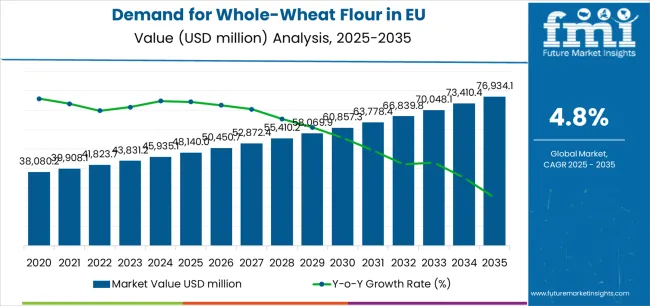
| Metric | Value |
|---|---|
| Market Value (2025) | USD 48,140 million |
| Market Forecast Value (2035) | USD 76,934.1 million |
| Forecast CAGR (2025-2035) | 4.8% |
Between 2025 and 2030, EU whole-wheat flour demand is projected to expand from USD 48,140.0 million to USD 60,760.3 million, resulting in a value increase of USD 12,620.3 million, which represents 44.3% of the total forecast growth for the decade. This phase of development will be shaped by rising consumer adoption of whole-grain diets, increasing availability of diverse whole-wheat flour varieties across bread, pancake, and specialty applications, and growing mainstream acceptance of whole-wheat products across retail bakeries, supermarket bread sections, and foodservice channels. Manufacturers are expanding their product portfolios to address evolving preferences for organic whole-wheat flour, stone-ground varieties, ancient grain blends, and clean-label formulations with minimal processing comparable to conventional refined flour offerings.
From 2030 to 2035, sales are forecast to grow from USD 60,760.3 million to USD 76,653.0 million, adding another USD 15,892.7 million, which constitutes 55.7% of the overall ten-year expansion. This period is expected to be characterized by further expansion of premium artisan bread applications, integration of advanced milling technologies preserving nutritional integrity while improving baking performance, and development of specialty whole-wheat flour products targeting health-conscious consumers and professional bakers. The growing emphasis on preventive nutrition and increasing consumer willingness to invest in nutritionally superior ingredients will drive demand for innovative whole-wheat flour products that deliver authentic taste, superior functionality, and documented health benefits including fiber content and micronutrient retention.
Between 2020 and 2025, EU whole-wheat flour sales experienced steady expansion at a CAGR of 4.7%, growing from USD 38,150.0 million to USD 48,140.0 million. This period was driven by increasing health consciousness among European populations, rising awareness of whole-grain benefits for digestive health and cardiovascular wellness, and growing recognition of whole-wheat flour's role in balanced nutrition. The industry developed as specialized millers and major flour producers recognized the commercial potential of whole-grain products addressing consumer health priorities. Product innovations, improved milling techniques preserving bran and germ components, and enhanced baking performance characteristics began establishing baker confidence and accelerating mainstream acceptance of whole-wheat flour across diverse applications.
Industry expansion is being supported by the rapid increase in health-conscious consumers across European countries and the corresponding demand for nutritionally superior, fiber-rich, and minimally processed flour products with proven benefits for digestive health, blood sugar management, and cardiovascular wellness. Modern bakeries and home bakers rely on whole-wheat flour as a foundational ingredient for health-positioned bread, nutritionally enhanced baked goods, premium artisan products, and whole-grain recipes supporting dietary guidelines recommending increased whole-grain consumption. Even minor nutritional concerns, such as inadequate fiber intake, elevated cholesterol levels, or blood sugar management, can drive comprehensive adoption of whole-wheat flour to maintain optimal wellness and support evidence-based nutritional strategies.
The growing awareness of chronic disease prevention and increasing recognition of whole-grain consumption's role in reducing cardiovascular disease risk, supporting digestive health through dietary fiber, and providing sustained energy release are driving demand for whole-wheat flour solutions from certified millers with appropriate quality credentials and verified whole-grain content. Regulatory authorities are increasingly establishing clear guidelines for whole-grain labeling, nutritional content claims, health claim substantiation, and quality requirements to maintain consumer safety and ensure product consistency. Scientific research studies and nutritional analyses are providing evidence supporting whole-wheat flour's health benefits and functional advantages, requiring specialized milling methods and standardized production protocols for preserving nutritional integrity including bran and germ retention, maintaining enzymatic activity for optimal dough development, and ensuring appropriate particle size distribution supporting acceptable baking performance across diverse applications including bread, pastries, and specialty products.
Sales are segmented by product type, application (end use), distribution channel, nature, and country. By product type, demand is divided into bread flour, pancake flour, cracker flour, and pizza flour. Based on application, sales are categorized into bread, bakery products, biscuits, rolls, cookies, buns, sweet goods, desserts, and tortillas. In terms of distribution channel, demand is segmented into B2B/direct sales and B2C/indirect sales. By nature, sales are classified into conventional and organic. Regionally, demand is focused on Germany, France, Italy, Spain, the Netherlands, and the Rest of Europe.
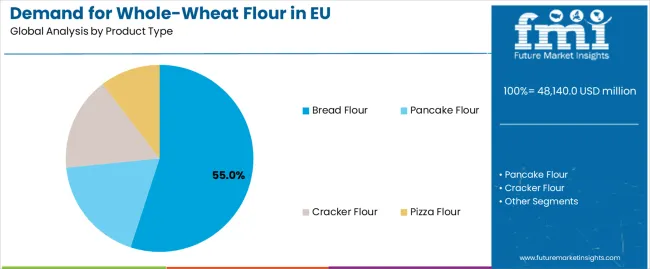
The bread flour segment is projected to account for 55.0% of EU whole-wheat flour sales in 2025, declining slightly to 53.0% by 2035 as specialty flour categories gain ground. This dominant position is fundamentally supported by bread's status as a dietary staple across European populations, whole-wheat bread flour's essential role in artisan and commercial bread production, and versatile functionality enabling use across diverse bread styles from rustic country loaves to sandwich bread. The bread flour format delivers exceptional performance, providing professional bakers and industrial manufacturers with flour solutions that contribute desirable texture, authentic whole-grain flavor, and nutritional positioning supporting health claims and dietary recommendations.
This segment benefits from mature milling infrastructure within Europe's established flour industry, extensive distribution networks from major millers including GoodMills Group and Groupe Soufflet, and comprehensive technical know-how supporting reliable bread-making performance across diverse baking conditions. Additionally, bread flour offers formulation flexibility across light whole-wheat varieties for consumer acceptance, traditional whole-wheat for authentic artisan products, and specialty blends incorporating ancient grains, supported by proven milling technologies that balance nutritional integrity with baking functionality.
The bread flour segment's declining share reflects diversification toward specialty applications including pancake and pizza flour rather than diminished absolute bread flour demand, with the segment maintaining clear leadership position throughout the forecast period given bread's fundamental importance in European dietary patterns and whole-wheat bread's growing positioning as a health-conscious staple alternative.
Key advantages include:
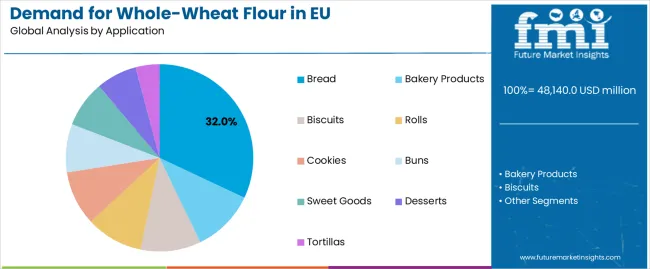
The bread application is positioned to represent 32.0% of total whole-wheat flour demand across European regions in 2025, declining slightly to 31.0% by 2035, reflecting the segment's dominance as the primary usage category within the overall industry ecosystem. This commanding share directly demonstrates that bread production represents the largest single application, with bakeries incorporating whole-wheat flour into sandwich bread, artisan loaves, rustic country bread, and specialty whole-grain products requiring consistent milling quality, reliable baking performance, and acceptable consumer taste profiles.
Modern bread manufacturers increasingly view whole-wheat flour as an essential ingredient for health-positioned product lines, driving demand for flour optimized for commercial production equipment, consistent water absorption characteristics, predictable dough development, and acceptable bread volume achieving balance between nutritional integrity and consumer palatability. The segment benefits from continuous product innovation focused on improved flavor profiles reducing bitter notes associated with bran components, enhanced texture development supporting softer crumb structure, and optimized fermentation performance enabling traditional artisan techniques.
Key advantages include:
B2B and direct sales channels, serving commercial bakeries, industrial food manufacturers, and large foodservice operations, are strategically estimated to control 66.0% of total European whole-wheat flour sales in 2025, declining to 63.0% by 2035 as retail consumer channels gain ground. This dominant position reflects the professional nature of flour procurement, where direct relationships between millers and commercial bakers enable technical support, quality consistency, bulk delivery logistics, and customized milling specifications supporting professional baking operations.
The segment provides essential value through technical consultation including formula optimization, process troubleshooting, and quality assurance supporting consistent baking results. Major European millers including GoodMills Group and ADM Milling maintain extensive direct supply relationships with commercial bakeries, industrial manufacturers, and foodservice distributors, leveraging technical partnerships for application development, ongoing performance optimization, and compliance with food safety standards.
Key advantages include:
Conventional whole-wheat flour products are strategically positioned to contribute 88.0% of total European sales in 2025, declining to 84.0% by 2035 as organic alternatives gain momentum. Conventional products represent whole-wheat flour produced through standard milling methods using conventionally grown wheat without organic certification requirements, successfully delivering consistent quality, competitive pricing, and reliable supply supporting both commercial baking operations and mainstream consumer purchases.
Conventional production serves cost-sensitive bakeries, large-scale industrial manufacturers, and mainstream consumers prioritizing value and accessibility over organic certification. The segment derives significant competitive advantages from established wheat supply chains, economies of scale in milling operations, and the ability to meet substantial volume requirements from major bakery chains without organic sourcing constraints limiting wheat variety selection and supplier flexibility.
Key advantages include:
EU whole-wheat flour sales are advancing steadily due to increasing health consciousness regarding whole-grain benefits, growing awareness of dietary fiber's importance for digestive and cardiovascular health, expanding artisan bakery sector emphasizing whole-grain products, and rising consumer education about nutritional advantages of whole-wheat versus refined flour. However, the industry faces challenges, including consumer taste preferences sometimes favoring refined flour's milder flavor, baking performance challenges requiring technical expertise for optimal results, price premiums limiting adoption among cost-sensitive consumers, and shelf-life considerations due to natural oil content in wheat germ affecting storage stability. Continued innovation in milling technologies, flavor optimization, and consumer education remains central to industry development.
The rapidly accelerating development of advanced milling technologies is fundamentally transforming whole-wheat flour production from traditional stone-grinding to precision milling systems enabling optimal balance between nutritional integrity and baking performance. Modern milling platforms featuring controlled particle size distribution, selective bran grinding reducing bitter flavors, and temperature-controlled processing preserving enzymatic activity allow millers to create whole-wheat flour with improved taste profiles, enhanced baking functionality, and maximized nutritional value without sacrificing the whole-grain definition requiring bran, germ, and endosperm retention.
These technological innovations prove particularly transformative for commercial baking applications, where consistent performance, predictable dough behavior, and acceptable taste profiles prove essential for mainstream consumer acceptance. Major flour mills invest heavily in advanced milling equipment, process optimization research, and wheat variety evaluation programs, recognizing that superior baking performance represents the critical factor enabling whole-wheat flour adoption beyond dedicated health-conscious consumers into mainstream bakery applications.
Modern whole-wheat flour producers systematically incorporate ancient grain varieties including spelt, einkorn, and emmer, heritage wheat cultivars with distinct flavor profiles, and specialty high-protein varieties optimizing specific baking applications. Strategic integration of grain diversity enables manufacturers to position whole-wheat flour as premium ingredients where flavor complexity, nutritional distinction, and artisan positioning prove increasingly important to discerning bakers and health-conscious consumers seeking alternatives to commodity whole-wheat flour.
These specialty grain innovations prove essential for premium positioning, as artisan bakeries demand unique flavor profiles supporting signature bread offerings, health-focused consumers seek grain varieties perceived as more nutritious or digestible, and gourmet food culture elevates ancient grains to trendy ingredient status. Companies implement grain sourcing programs, contract farming arrangements with specialty wheat growers, and milling protocols optimized for specific grain characteristics supporting quality differentiation and premium pricing strategies.
European consumers and professional bakers increasingly prioritize whole-wheat flour sourcing transparency featuring documented wheat origin, farming practices verification, and milling process disclosure supporting informed purchasing decisions. This transparency trend enables millers to differentiate premium offerings through origin labeling, farmer partnership storytelling, and supply chain traceability systems documenting wheat journey from field to flour bag supporting authenticity claims and ethical sourcing narratives.
The development of blockchain-based traceability systems, direct farmer relationships enabling origin specificity, and transparent milling practices including facility tours and process documentation expands millers' abilities to create consumer trust while supporting premium positioning. Brands collaborate with wheat farmers, agricultural cooperatives, and certification bodies to develop transparent supply chains addressing consumer interest in food system understanding and ethical production practices.
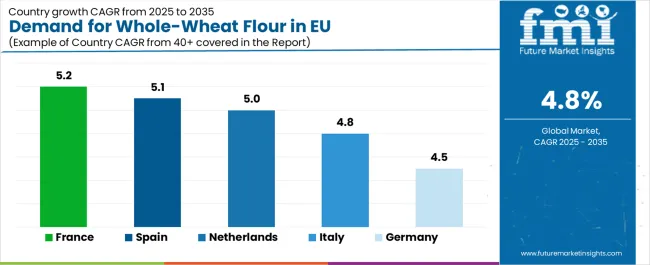
| Country | CAGR % (2025 – 2035) |
|---|---|
| France | 5.2% |
| Netherlands | 5% |
| Spain | 5.1% |
| Italy | 4.8% |
| Germany | 4.5% |
EU whole-wheat flour sales demonstrate varied growth across major European economies, with France and Netherlands leading expansion at 5.2% CAGR and 5.0% through 2035, driven by strong health consciousness and organic food culture. Spain shows robust 5.1% CAGR supported by growing wellness awareness. Italy exhibits solid 4.8% growth aligned with overall EU expansion. Germany maintains leadership with 4.5% CAGR through established bakery culture and whole-grain acceptance. Rest of Europe demonstrates 4.4% growth reflecting emerging whole-grain adoption.
Revenue from whole-wheat flour in Germany is projected to exhibit solid growth with a CAGR of 4.5% through 2035, driven by well-developed bakery infrastructure, strong bread consumption culture, and established whole-grain product acceptance throughout the country. Germany's sophisticated bakery sector featuring extensive artisan bakery networks and internationally recognized bread craftsmanship creates substantial demand for diverse whole-wheat flour varieties across all application segments from traditional whole-grain bread to specialty baked goods.
Major flour mills including GoodMills Group and regional millers systematically expand whole-wheat flour portfolios, often dedicating extensive development resources to baking performance optimization and organic product certification. German demand benefits from strong consumer health consciousness supporting whole-grain bread purchasing, substantial home baking tradition creating retail flour opportunities, and cultural emphasis on bread quality naturally extending to whole-wheat varieties positioned as nutritionally superior alternatives.
Key drivers include:
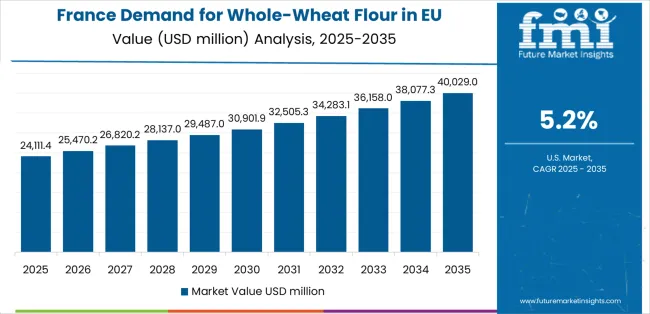
Revenue from whole-wheat flour in France is expanding at a CAGR of 5.2%, the highest among major European countries, substantially supported by rapidly evolving consumer attitudes toward preventive nutrition, growing recognition of whole-grain benefits for chronic disease prevention, and expanding organic food sector. France's increasing health consciousness among urban populations and rising awareness of dietary fiber's importance are systematically driving demand for whole-wheat flour across diverse categories from artisan bread to home baking.
Major milling groups including Groupe Soufflet and regional flour producers strategically expand whole-wheat flour offerings, particularly within organic product lines, artisan bakery channels, and health-focused retail brands. French sales particularly benefit from growing consumer education about nutritional differences between refined and whole-wheat flour, expanding artisan bakery sector embracing whole-grain products, and premium positioning enabling investment in high-quality milling processes preserving nutritional integrity.
Key drivers include:
Revenue from whole-wheat flour in Italy is growing at a CAGR of 4.8%, aligned with overall EU expansion, fundamentally driven by traditional pasta and bread applications incorporating whole-wheat varieties, growing health consciousness particularly among younger consumers, and expanding artisan bakery sector throughout Italian cities. Italy's renowned culinary heritage is gradually accommodating whole-wheat alternatives as consumers recognize health benefits while maintaining quality expectations.
Major food manufacturers and regional millers strategically invest in whole-wheat flour applications for pasta production, artisan bread, and specialty baked goods. Italian sales particularly benefit from pasta culture providing natural adoption pathway for whole-wheat durum flour, strong bakery tradition extending to whole-grain varieties, and growing health consciousness driving nutritional optimization of traditional Italian foods.
Key drivers include:
Demand for whole-wheat flour in Spain is projected to grow at a CAGR of 5.1%, substantially supported by growing wellness consciousness, expanding health food retail sector, and modernizing bakery industry incorporating nutritional enhancement strategies. Spanish consumer increasing health awareness particularly among urban populations is systematically driving demand for whole-wheat flour across bread, bakery products, and home baking applications.
Major food manufacturers and bakery suppliers strategically expand whole-wheat flour offerings, with particular emphasis on organic varieties, health-positioned bread products, and specialty baking flour targeting health-conscious consumers. Spain's growing health food retail presence including specialized organic stores and health-focused supermarket sections provides expanding distribution for premium whole-wheat flour products.
Key drivers include:
Demand for whole-wheat flour in the Netherlands is expanding at a CAGR of 5.0%, matching France as the highest growth rate, fundamentally driven by exceptional health consciousness, strong organic food culture, and sophisticated consumer base prioritizing preventive nutrition and whole-grain consumption. Dutch consumers demonstrate particularly high receptivity to nutritional messaging and willingness to invest in health-positioned food products including premium whole-wheat flour.
Netherlands sales significantly benefit from well-developed organic retail infrastructure, strong consumer education about whole-grain benefits, and sophisticated food culture valuing quality and nutritional integrity. The country demonstrates high per-capita organic food consumption supporting organic whole-wheat flour adoption and serves as innovation testing ground for premium flour products.
Key drivers include:
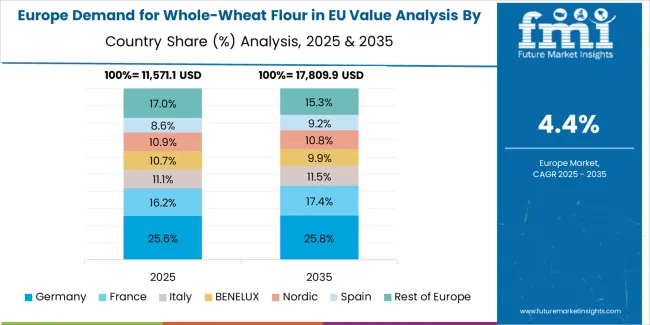
Demand for whole-wheat flour in the Rest of Europe region is projected to grow at a CAGR of 4.4%, driven by emerging whole-grain awareness in Eastern European countries including Poland, Czech Republic, and Romania, increasing health consciousness across smaller European territories, and expanding modern retail providing access to diverse flour varieties. These areas benefit from improving nutritional education, growing middle-class consumer base, and increasing exposure to Western European health trends.
The Rest of Europe region demonstrates growth potential as whole-wheat flour adoption accelerates from relatively lower baseline compared to mature Western European countries. Regional bakeries and food manufacturers increasingly recognize opportunities to introduce whole-wheat products addressing growing consumer interest in health-positioned alternatives to refined flour products.
Key drivers include:
EU whole-wheat flour sales are projected to grow from USD 48,140.0 million in 2025 to USD 76,653.0 million by 2035, registering a CAGR of 4.8% over the forecast period. France and the Netherlands are expected to demonstrate the strongest growth trajectory with a 5.2% CAGR each, supported by advanced health consciousness and strong organic food movements. Spain follows with 5.1% CAGR, attributed to growing wellness trends. Germany maintains the largest share at 27.6% in 2025, valued at USD 13,281.7 million, growing at 4.5% CAGR. Italy accounts for 16.0% with 4.8% CAGR, while Rest of Europe holds 18.7% share growing at 4.4% CAGR.
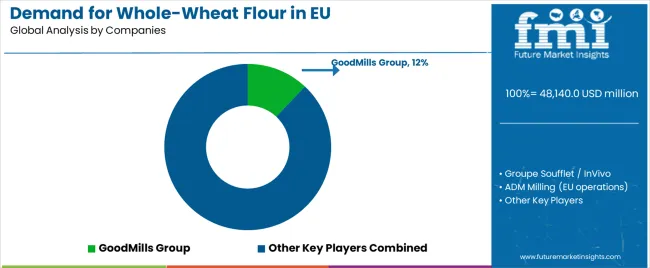
EU whole-wheat flour sales are defined by competition among large integrated millers, regional flour producers, and specialized organic millers. Companies are investing in advanced milling technologies, organic certification, baking performance optimization, and technical support services to deliver high-quality, functionally superior, and nutritionally verified whole-wheat flour solutions. Strategic partnerships with commercial bakeries, technical consultation services, and transparent sourcing programs are central to strengthening competitive position.
GoodMills Group holds an estimated 12.0% share, leveraging its position as the largest flour miller in Europe with comprehensive milling infrastructure, extensive distribution networks, and established relationships with commercial bakeries and industrial food manufacturers. GoodMills benefits from multi-country operations across Germany, Austria, and other European countries, combined with technical expertise supporting whole-wheat flour formulation optimization and consistent quality delivery.
Groupe Soufflet / InVivo accounts for approximately 10.0% share, emphasizing strong French presence, comprehensive bakery supply networks, and vertical integration across wheat procurement and flour milling. Groupe Soufflet's success in developing relationships with French artisan bakeries, industrial bread manufacturers, and retail distribution creates strong positioning in EUropean whole-wheat flour sector.
ADM Milling (EU operations) represents roughly 9.0% share through its position as a global agribusiness with substantial European milling capacity, broad industrial customer base, and technical expertise supporting diverse flour applications. ADM benefits from integrated supply chains, processing technology leadership, and ability to serve large-scale food manufacturers requiring consistent quality and reliable supply.
General Mills (Gold Medal brand) holds approximately 6.0% share, supporting growth through retail brand strength, foodservice presence, and consumer marketing expertise. General Mills leverages brand recognition, consumer trust, and retail distribution supporting whole-wheat flour sales in home baking and foodservice channels.
Ardent Mills (EU partnerships) accounts for around 4.0% share through select European contracts and distribution partnerships, providing specialized flour varieties and technical expertise supporting premium and specialty applications. Ardent Mills leverages North American milling expertise and innovation capabilities attracting European customers seeking advanced flour solutions.
Other companies including regional millers, organic specialists, and local producers collectively hold 59.0% share, reflecting moderate fragmentation in European whole-wheat flour sales, where numerous regional millers, specialized organic flour producers, local bakery suppliers, and cooperative mills serve local areas, specific customer relationships, and niche applications. This competitive diversity provides opportunities for differentiation through organic certification, local sourcing, heritage wheat varieties, and technical service excellence resonating with artisan bakeries and health-conscious consumers seeking premium alternatives.
| Item | Value |
|---|---|
| Quantitative Units | USD 76,934.1 million |
| Product Type | Bread Flour, Pancake Flour, Cracker Flour, Pizza Flour |
| Application | Bread, Bakery Products, Biscuits, Rolls, Cookies, Buns, Sweet Goods, Desserts, Tortillas |
| Distribution Channel | B2B/Direct Sales, B2C/Indirect Sales |
| Nature | Conventional, Organic |
| Countries Covered | Germany, France, Italy, Spain, the Netherlands, and the Rest of Europe |
| Key Companies Profiled | GoodMills Group, Groupe Soufflet/InVivo, ADM Milling, General Mills, Ardent Mills, Regional specialists |
| Additional Attributes | Dollar sales by product type, application, distribution channel, and nature; regional demand trends across major European countries; competitive landscape analysis with established millers and specialized organic producers; customer preferences for various flour specifications and baking applications; integration with advanced milling technologies and nutritional retention systems; innovations in baking performance optimization and flavor enhancement; adoption across commercial bakeries and home baking segments; regulatory framework analysis for whole-grain definitions and health claim requirements; supply chain strategies; and penetration analysis for professional bakers and health-conscious consumers. |
The global demand for whole-wheat flour in EU is estimated to be valued at USD 48,140.0 million in 2025.
The market size for the demand for whole-wheat flour in EU is projected to reach USD 76,934.1 million by 2035.
The demand for whole-wheat flour in EU is expected to grow at a 4.8% CAGR between 2025 and 2035.
The key product types in demand for whole-wheat flour in EU are bread flour, pancake flour, cracker flour and pizza flour.
In terms of application, bread segment to command 32.0% share in the demand for whole-wheat flour in EU in 2025.






Our Research Products

The "Full Research Suite" delivers actionable market intel, deep dives on markets or technologies, so clients act faster, cut risk, and unlock growth.

The Leaderboard benchmarks and ranks top vendors, classifying them as Established Leaders, Leading Challengers, or Disruptors & Challengers.

Locates where complements amplify value and substitutes erode it, forecasting net impact by horizon

We deliver granular, decision-grade intel: market sizing, 5-year forecasts, pricing, adoption, usage, revenue, and operational KPIs—plus competitor tracking, regulation, and value chains—across 60 countries broadly.

Spot the shifts before they hit your P&L. We track inflection points, adoption curves, pricing moves, and ecosystem plays to show where demand is heading, why it is changing, and what to do next across high-growth markets and disruptive tech

Real-time reads of user behavior. We track shifting priorities, perceptions of today’s and next-gen services, and provider experience, then pace how fast tech moves from trial to adoption, blending buyer, consumer, and channel inputs with social signals (#WhySwitch, #UX).

Partner with our analyst team to build a custom report designed around your business priorities. From analysing market trends to assessing competitors or crafting bespoke datasets, we tailor insights to your needs.
Supplier Intelligence
Discovery & Profiling
Capacity & Footprint
Performance & Risk
Compliance & Governance
Commercial Readiness
Who Supplies Whom
Scorecards & Shortlists
Playbooks & Docs
Category Intelligence
Definition & Scope
Demand & Use Cases
Cost Drivers
Market Structure
Supply Chain Map
Trade & Policy
Operating Norms
Deliverables
Buyer Intelligence
Account Basics
Spend & Scope
Procurement Model
Vendor Requirements
Terms & Policies
Entry Strategy
Pain Points & Triggers
Outputs
Pricing Analysis
Benchmarks
Trends
Should-Cost
Indexation
Landed Cost
Commercial Terms
Deliverables
Brand Analysis
Positioning & Value Prop
Share & Presence
Customer Evidence
Go-to-Market
Digital & Reputation
Compliance & Trust
KPIs & Gaps
Outputs
Full Research Suite comprises of:
Market outlook & trends analysis
Interviews & case studies
Strategic recommendations
Vendor profiles & capabilities analysis
5-year forecasts
8 regions and 60+ country-level data splits
Market segment data splits
12 months of continuous data updates
DELIVERED AS:
PDF EXCEL ONLINE
Western Europe Banana Flour Market Analysis by Source, Application, Distribution Channel, and Country Through 2025 to 2035
Western Europe Whole Wheat Flour Market Analysis – Trends, Demand & Forecast 2025–2035
Demand for Bean Flour in EU Size and Share Forecast Outlook 2025 to 2035
Demand for Banana Flour in EU Size and Share Forecast Outlook 2025 to 2035
Demand for Chickpea Flour in EU Size and Share Forecast Outlook 2025 to 2035
Europe Radiotherapy Patient Positioning Market Size and Share Forecast Outlook 2025 to 2035
Europe Polyvinyl Alcohol Industry Analysis Size and Share Forecast Outlook 2025 to 2035
Europe Cruise Market Forecast and Outlook 2025 to 2035
Europium Market Forecast and Outlook 2025 to 2035
Eucommia Leaf Extract Market Size and Share Forecast Outlook 2025 to 2035
Europe Massage Therapy Service Market Size and Share Forecast Outlook 2025 to 2035
Europe Cement Market Analysis Size and Share Forecast Outlook 2025 to 2035
European Union Tourism Industry Size and Share Forecast Outlook 2025 to 2035
Europe Injection Molding Machines Market Size and Share Forecast Outlook 2025 to 2035
Europe Injection Moulders Market Size and Share Forecast Outlook 2025 to 2035
Europe and MENA Generic Oncology Drug Market Size and Share Forecast Outlook 2025 to 2035
Europe Masking Tapes Market Size and Share Forecast Outlook 2025 to 2035
Europe Liners Market Size and Share Forecast Outlook 2025 to 2035
Europe Dermal Fillers Market Size and Share Forecast Outlook 2025 to 2035
Europe Trolley Bus Market Size and Share Forecast Outlook 2025 to 2035

Thank you!
You will receive an email from our Business Development Manager. Please be sure to check your SPAM/JUNK folder too.
Chat With
MaRIA